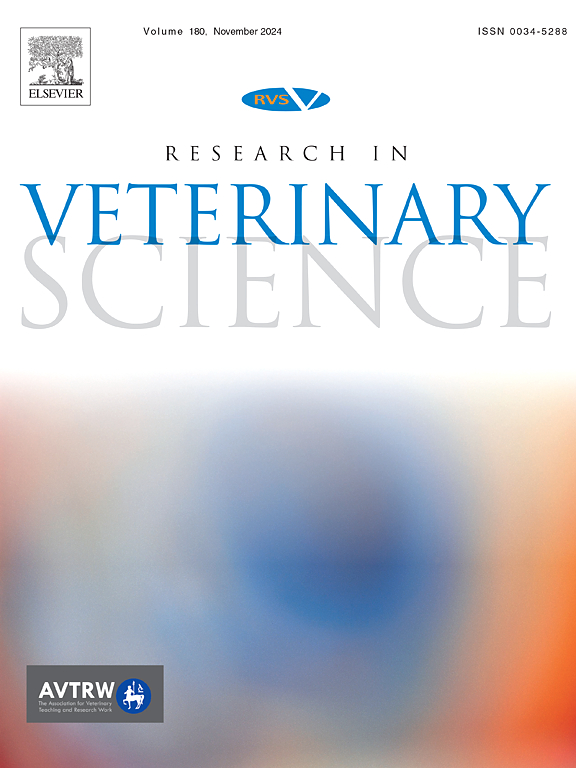Performance of the PhoP (Rv0757/Mb0780) protein as diagnostic antigen for bovine tuberculosis
IF 2.2
3区 农林科学
Q1 VETERINARY SCIENCES
引用次数: 0
Abstract
Bovine tuberculosis (bTB), a global zoonotic disease, causes negative effects on human and animal health. PhoP protein is a key regulator of pathogenic phenotypes in members of the Mycobacterium tuberculosis complex, which includes the causative agent of bTB. Despite extensive research on this protein focused in deciphering its regulatory role, little was explored about it as a diagnostic antigen. In humans, a novel role of anti-PhoP antibodies as a possible marker for the diagnosis of TB was demonstrated. However, this issue was not addressed in bovines. In this study, antigenic properties of the PhoP protein were evaluated in naturally Mycobacterium bovis (M. bovis) infected bovines. A high homology of PhoP (≥ 75 %) was observed in environmental mycobacterial species and other genera such as Salmonella and Pasteurella. Using the IFN-gamma release assay (IGRA), we detected cell-mediated immune response against PhoP in cattle from infected herds (25 %; IC 95 % 3.2–65.1), although it was significantly lower than that evoked by the reference antigens, ESAT-6/CFP-10/Rv3615c (75 %; IC95 % 34.9–96.8), and the purified protein derivative (87.5 %; IC 95 % 47.4–99.7) (p < 0.05)). Animals from a bTB free area showed no response against PhoP when analyzed by IGRA. Although, the humoral response detected 62.5 % (CI95% 24.5–91.5) of naturally infected animals, there was 100 % cross-reactivity among TB-free cattle. These results suggest that the PhoP protein is not a promising candidate for bTB diagnosis, due to it had relatively low levels of test sensitivity in the IGRA test, and very low specificity in a humoral antibody western blot assay.
PhoP (Rv0757/Mb0780)蛋白作为牛结核病诊断抗原的研究
牛结核病(bTB)是一种全球性人畜共患疾病,对人类和动物健康造成负面影响。PhoP蛋白是结核分枝杆菌复合体成员致病性表型的关键调节因子,结核分枝杆菌复合体包括bTB的病原体。尽管对这种蛋白的广泛研究集中在解读其调节作用,但很少有人探讨它作为诊断抗原。在人类中,抗phop抗体作为结核病诊断的可能标记物的新作用被证明。然而,这个问题并没有在牛身上得到解决。在这项研究中,PhoP蛋白的抗原性在自然感染牛分枝杆菌(牛分枝杆菌)的牛中被评估。PhoP在环境分枝杆菌和其他属(如沙门氏菌和巴氏杆菌)中具有较高的同源性(≥75%)。利用ifn - γ释放试验(IGRA),我们检测了感染牛群(25%;ic95 % 3.2 ~ 65.1),但明显低于参考抗原ESAT-6/CFP-10/Rv3615c (75 %;IC95 % 34.9-96.8),纯化蛋白衍生物(87.5%;IC 95% 47.4-99.7) (p
本文章由计算机程序翻译,如有差异,请以英文原文为准。
求助全文
约1分钟内获得全文
求助全文
来源期刊

Research in veterinary science
农林科学-兽医学
CiteScore
4.40
自引率
4.20%
发文量
312
审稿时长
75 days
期刊介绍:
Research in Veterinary Science is an International multi-disciplinary journal publishing original articles, reviews and short communications of a high scientific and ethical standard in all aspects of veterinary and biomedical research.
The primary aim of the journal is to inform veterinary and biomedical scientists of significant advances in veterinary and related research through prompt publication and dissemination. Secondly, the journal aims to provide a general multi-disciplinary forum for discussion and debate of news and issues concerning veterinary science. Thirdly, to promote the dissemination of knowledge to a broader range of professions, globally.
High quality papers on all species of animals are considered, particularly those considered to be of high scientific importance and originality, and with interdisciplinary interest. The journal encourages papers providing results that have clear implications for understanding disease pathogenesis and for the development of control measures or treatments, as well as those dealing with a comparative biomedical approach, which represents a substantial improvement to animal and human health.
Studies without a robust scientific hypothesis or that are preliminary, or of weak originality, as well as negative results, are not appropriate for the journal. Furthermore, observational approaches, case studies or field reports lacking an advancement in general knowledge do not fall within the scope of the journal.
 求助内容:
求助内容: 应助结果提醒方式:
应助结果提醒方式:


